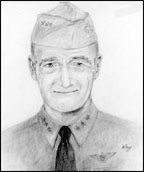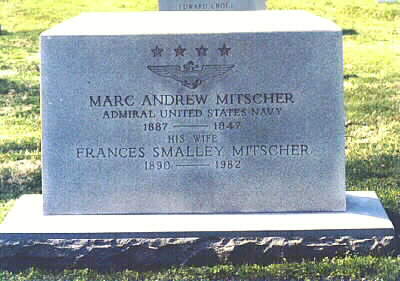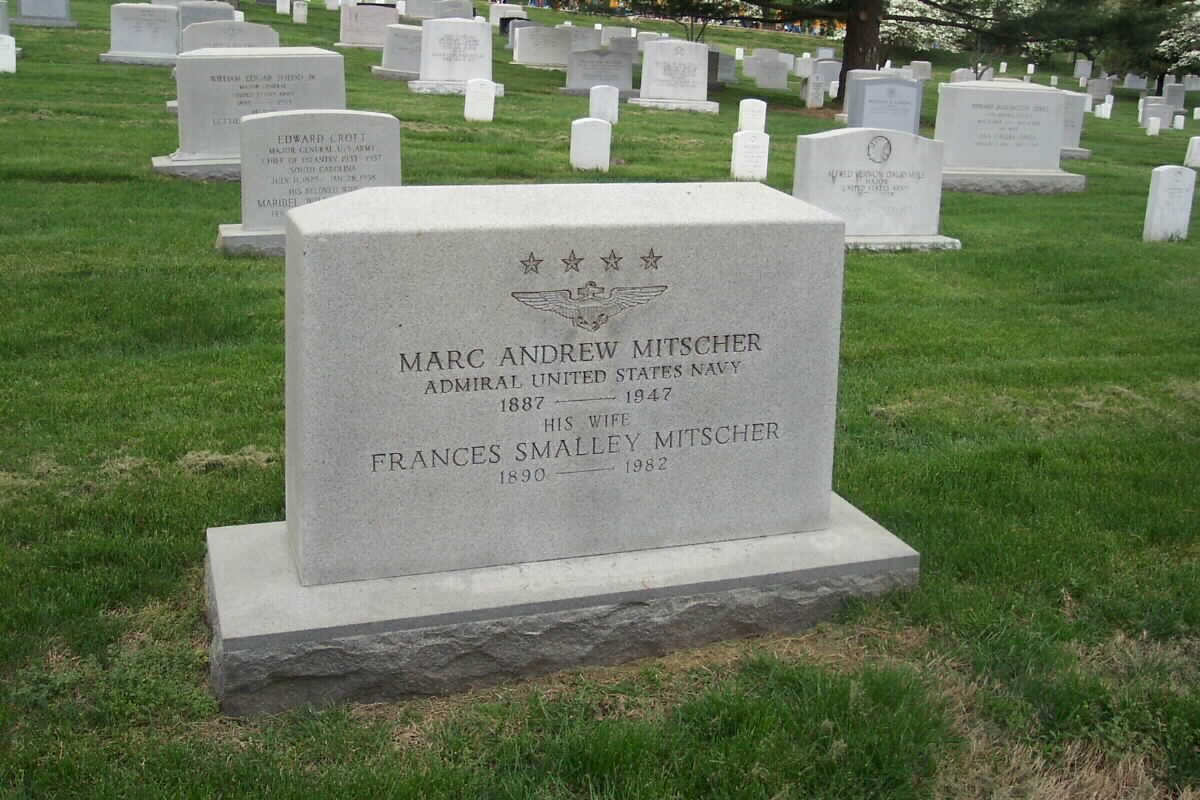A 1910 graduate of the United States Naval Academy, he was a pioneer Naval Aviator whose early service included duty as pilot of the NC-1 seaplane during the 1919 trans-Atlantic flight of the NC-4.
He was Captain of the USS Hornet when Pearl Harbor was attacked, and he commanded that aircraft carrier on the Doolittle raids against Tokyo, April 18, 1942, and in the Battle of Midway, June 3-7, 1942. In 1943, he was the overall commander, Fleet Air, Solomon Islands, and was the overall tactical commander of the operations that resulted in the shooting-down the aircraft carrying Japanese Admiral Isoruku Yamamoto on April 18, 1943.
In January 1944, he became commander of Carrier Division 3, which later became Fast Carrier Task Force 58. He stayed in that post, as a Vice Admiral, through the rest of World War II. Welded fast carriers into a fighting team that fought the Battles of Philippine Sea, June 19-20, 1944, and Gulf of Leyte, October 24-25, 1944, and bested the Japanese Kamikazes in the Okinawa Campaign in the Spring of 1945.
He was offered the post of Chief of Naval Operations, but turned it down to become commander of the 8th Fleet and then Commander-in-Chief, Atlantic Fleet, where he served until his death from heart problems on February 3, 1947. He was buried in Section 2 of Arlington National Cemetery.
Courtesy of the National Aviation Hall of Fame
Admiral Marc A. Mitscher earned distinction as one of the U.S. Navy’s great battle commanders in the 41 years he served his country.
Marc Andrew Mitscher was born in Hillsboro, Wisconsin on January 26, 1887. While growing up in the Washington, D.C. area, he attended intermediate and high school there. In 1906, he received his appointment to the U.S. Naval Academy. He graduated in 1910 and served at sea for two years, as required by law at that time, before being commissioned on March 7, 1912.
In August 1913 he served aboard the USS California on the West Coast during the Mexican Campaign. After subsequent duty on the destroyers Whipple and Stewart, he reported for aviation training at Naval Aeronautic Station, Pensacola, on board USS North Carolina, one of the first Navy ships to carry an airplane. Mitscher was designated Naval Aviator #33 on June 2, 1916 and remained at NAS, Pensacola for duty and further instruction.
On April 6, 1917, he reported to USS Huntington for duty in connection with aircraft catapult experiments, which was followed by various assignments until February 1919 when he was transferred to the Aviation Section in the office of the Chief of Naval Operations. Later in 1919 Mitscher, then a lieutenant commander, piloted one of the three NC seaplanes that attempted the first airborne transatlantic crossing. The NC-4, not piloted by Mitscher, went on to make
the successful, historic crossing. Then, Admiral Mitscher joined the USS Aroostook with additional duty later commanding the Detachment of Air Forces at Fleet Air Base, San Diego, California. He was then assigned to the Plans Division, Bureau of Aeronautics in 1922.
Mitscher made the USS Saratoga’s first takeoff and landing on January 11, 1928 in a Vought UO-l. He left Saratoga in June 1929 to return to the USS Langley, the carrier on which he was assigned for a brief period in 1926. The Admiral had a series of staff and command assignments until July 1941 when he went to Norfolk,Virginia, for the duty in fitting out USS Hornet. The carrier was commissioned on October 20, 1941, and Captain Marc Mitscher became her first commanding officer. During World War II, the Hornet was the “Shangri-La” from which American planes, under the command of Army Lieutenant Colonel James H. Doolittle, took off on April 18, 1942, to bomb military targets on the Japanese homeland. Aboard the Hornet, Mitscher led several successful attacks against the enemy carrier forces. He was relieved of command of the Hornet in July 1942, three months before she was sunk in an air attack at the Battle of Santa Cruz Islands.
Mitscher then commanded Patrol Wing Two until December 1942, when he became Commander Fleet Wing, Noumea. In April 1943, now a rear admiral, Mitscher went to Guadalcanal as Commander Air, Solomon Islands, in charge of the Navy, Army, Marine and Royal New Zealand Air Force units. Guadalcanal had been secured but was still under constant enemy fire from the Japanese occupying the North Islands. Vice Admiral Halsey sent Mitscher, according to Admiral Arleigh Burke, because he “was a fighting fool and could handle the tough job.”
When Mitscher assumed command of Task Force 58 in 1944, the mighty Naval force opened the campaign to capture the Marshall Islands. Under Mitscher’s leadership and guided by his wisdom, Task Force 58 contributed directly to the capture and occupation of the Marshalls in February, 1944. In the days that followed, Mitscher led his task forces in attacks against heavily fortified Japanese bases. In the closing months of the war, Admiral Mitscher used many innovative tactics as he experimented with formations and maneuvers, leading a series of
attacks against the Japanese home forces.
He returned to the U.S. as Deputy chief of Naval Operations on July 10, 1945, and was appointed to the rank of Admiral and assumed command of the Eighth Fleet on March 1, 1946. He became Commander in Chief, U.S. Atlantic Fleet in September of 1946. After 41 years of continuous Naval service, Admiral Marc A. Mitscher died of a heart attack on February 3, 1947. Admiral Arleigh Burke attributed Mitscher as being a “bulldog of a fighter, a strategist blessed with an uncanny ability to foresee his enemy’s next move. He was above all else, a Naval Aviator.”
Michael Robert Patterson was born in Arlington and is the son of a former officer of the US Army. So it was no wonder that sooner or later his interests drew him to American history and especially to American military history. Many of his articles can be found on renowned portals like the New York Times, Washingtonpost or Wikipedia.
Reviewed by: Michael Howard



